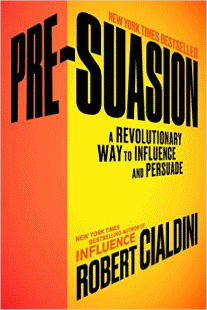I'm reading Robert Cialdini's latest book, Pre-Suasion: A Revolutionary Way to Influence and Persuade. Dr. Cialdini is the social psychologist who wrote the 1986 classic, Influence: The Psychology of Persuasion.
Dr. Cialdini's work should be familiar to any student of direct-response advertising techniques. For example, the idea of using testimonials as "social proof" came from his work.
In his latest book, I have come across two compelling findings (so far) with direct relevance to our industry.
1. Fear Makes Us Want to Fit in, Arousal to Stand Out
In the section of the book titled "Commanders of Attention," Dr. Cialdini examines how our reaction to threatening stimuli primes us to be influenced in a completely different way than our reaction to sexual stimuli:
[W]e realized that humans encountering threatening circumstances would have developed early on a strong tendency to be part of a group (where there is safety and strength in numbers) and to avoid being separate (where there is vulnerability to a predator or enemy). The opposite would be true, however, in a situation with sexual possibilities. There a person would want distance from the pack in order to be the prime recipient of romantic consideration.
We also realized that these two contrary motivations, to fit in and to stand out, map perfectly onto a pair of longtime favorite commercial appeals. One, of the 'Don’t be left out' variety, urges us to join the many. The other, of the 'Be one of the few' sort, urges us to step away from the many. So, which would an advertiser be better advised to launch into the minds of prospects?
The answer: It depends. This is where it gets really interesting. Dr. Cialdini suggests that a new way to improve response may be to go deeper than demographics when considering ad placement — because certain types of content work with your main motivating message and certain types of content work against it.
[T]he popularity-based message would be the right one in any situation where audience members had been exposed to frightening stimuli—perhaps in the middle of watching a violent film on TV—because threat-focused people want to join the crowd. But sending that message in an ad to an audience watching a romantic film on TV would be a mistake, because amorously focused people want to step away from the crowd.
The same thinking applies to the content within a commercial, of course. Sex sells, but only in the right context. "Put people in a wary state of mind ... and, driven by a desire for safety, a popularity-based appeal will soar, whereas a distinctiveness-based appeal will sink," Cialdini writes. "But use it to put people in an amorous state of mind, and, driven by a consequent desire to stand out, the reverse will occur."
2. Cuts are Crucial, But Less is More
While studying mass media at the Annenberg School for Communication and Journalism, Dr. Cialdini met an expert in TV advertising. From her, he learned some of the techniques of what he calls "persuasion-oriented producers." In particular, he learned that:
[C]uts are crucial to persuasive success because they can be manipulated to bring into focus the feature of a message the persuader believes to be most convincing— by shifting the scene to that feature. That cut will instigate an orienting response to the winning feature in audience members’ brains before they even experience it [consciously].
A handful of top-shelf producers in our industry are masters of this technique. When you watch their commercials, you don't even realize that your attention is being directed. It feels like your eyes are simply focusing on something you wanted to see more closely. It just so happens that is the exact thing you need to see to be sold. Indeed, many times viewers (including myself) don't even notice there was a cut. It takes a careful review of the commercial to catch it.
Given the power of this technique, it's no surprise most major advertisers deploy it frequently. However, Dr. Cialdini writes that cuts must be used "judiciously to direct attention solely to the most important facets" of your material. Too bad most advertisers haven't learned that lesson.
Research confirms that ... TV advertisers have chosen instead to increase indiscriminately and dramatically the overall frequency of scene shifts within their ads by more than 50 percent over the years. Predictably, viewers end up confused as to the point of the ad and irritated by having their focus whipped around so often and so haphazardly. As a result, even though cut-heavy TV commercials draw more total attention, they produce significantly less memory for the ad’s persuasive claims and significantly less persuasion. It’s easy to understand why: viewers’ attention isn’t fixated on the ads’ best points but is scattered all over the material’s relevant and irrelevant attributes. For everyone concerned, it’s a case of death by a thousand cuts.
This is one of the crucial things amateur producers get wrong. I see it all the time. Quick cuts create confusion, and confusion is a sales killer.
*****
Should I discover some other relevant psychological techniques as I finish the book, I'll be sure to post about them. In the meantime, I highly recommend both of Dr. Cialdini's books. Links below.
